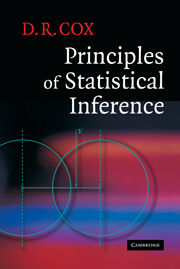Refine search
Actions for selected content:
2348 results in Statistical theory and methods
Frontmatter
-
- Book:
- Principles of Applied Statistics
- Published online:
- 07 September 2011
- Print publication:
- 28 July 2011, pp i-iv
-
- Chapter
- Export citation
References
-
- Book:
- Principles of Applied Statistics
- Published online:
- 07 September 2011
- Print publication:
- 28 July 2011, pp 189-197
-
- Chapter
- Export citation
6 - Model formulation
-
- Book:
- Principles of Applied Statistics
- Published online:
- 07 September 2011
- Print publication:
- 28 July 2011, pp 90-117
-
- Chapter
- Export citation
8 - Techniques of formal inference
-
- Book:
- Principles of Applied Statistics
- Published online:
- 07 September 2011
- Print publication:
- 28 July 2011, pp 140-158
-
- Chapter
- Export citation
Index
-
- Book:
- Principles of Applied Statistics
- Published online:
- 07 September 2011
- Print publication:
- 28 July 2011, pp 198-202
-
- Chapter
- Export citation
4 - Principles of measurement
-
- Book:
- Principles of Applied Statistics
- Published online:
- 07 September 2011
- Print publication:
- 28 July 2011, pp 53-74
-
- Chapter
- Export citation
Preface
-
- Book:
- Principles of Applied Statistics
- Published online:
- 07 September 2011
- Print publication:
- 28 July 2011, pp ix-x
-
- Chapter
- Export citation
5 - Preliminary analysis
-
- Book:
- Principles of Applied Statistics
- Published online:
- 07 September 2011
- Print publication:
- 28 July 2011, pp 75-89
-
- Chapter
- Export citation

Statistical Models
-
- Published online:
- 29 March 2011
- Print publication:
- 04 August 2003

Principles of Statistical Inference
-
- Published online:
- 17 March 2011
- Print publication:
- 10 August 2006
Preface to the second edition
-
- Book:
- Negative Binomial Regression
- Published online:
- 05 June 2012
- Print publication:
- 17 March 2011, pp xi-xviii
-
- Chapter
- Export citation
3 - Overview of count response models
-
- Book:
- Negative Binomial Regression
- Published online:
- 05 June 2012
- Print publication:
- 17 March 2011, pp 30-42
-
- Chapter
- Export citation
11 - Problems with zero counts
-
- Book:
- Negative Binomial Regression
- Published online:
- 05 June 2012
- Print publication:
- 17 March 2011, pp 346-386
-
- Chapter
- Export citation
Contents
-
- Book:
- Negative Binomial Regression
- Published online:
- 05 June 2012
- Print publication:
- 17 March 2011, pp v-x
-
- Chapter
- Export citation
2 - The concept of risk
-
- Book:
- Negative Binomial Regression
- Published online:
- 05 June 2012
- Print publication:
- 17 March 2011, pp 15-29
-
- Chapter
- Export citation
12 - Censored and truncated count models
-
- Book:
- Negative Binomial Regression
- Published online:
- 05 June 2012
- Print publication:
- 17 March 2011, pp 387-406
-
- Chapter
- Export citation
13 - Handling endogeneity and latent class models
-
- Book:
- Negative Binomial Regression
- Published online:
- 05 June 2012
- Print publication:
- 17 March 2011, pp 407-446
-
- Chapter
- Export citation
1 - Introduction
-
- Book:
- Negative Binomial Regression
- Published online:
- 05 June 2012
- Print publication:
- 17 March 2011, pp 1-14
-
- Chapter
- Export citation
15 - Bayesian negative binomial models
-
- Book:
- Negative Binomial Regression
- Published online:
- 05 June 2012
- Print publication:
- 17 March 2011, pp 502-519
-
- Chapter
- Export citation
Frontmatter
-
- Book:
- Negative Binomial Regression
- Published online:
- 05 June 2012
- Print publication:
- 17 March 2011, pp i-iv
-
- Chapter
- Export citation
